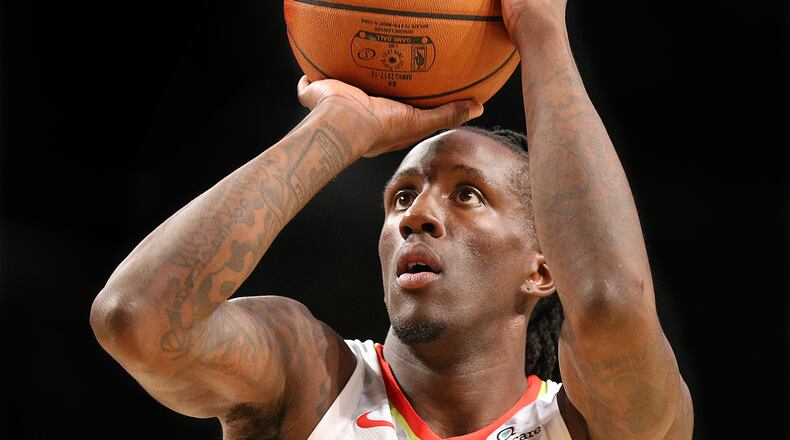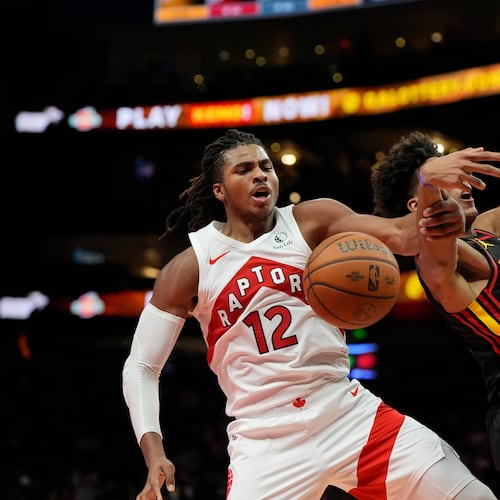Over the next several days I’ll review each Hawks player on the roster in descending order of minutes played. This is the first entry.
The departures of Thabo Sefolosha and Tim Hardaway from last season's Hawks team opened a major role on the wing for Taurean Prince. Prince proved to be durable in his second pro season with 82 starts and 2,464 minutes played. Only seven other NBA players started every game this season.
Prince emerged as a legitimate high-volume 3-point shooter in his second pro season, which is a very promising development. Prince launched 3-pointers on 47 percent of his overall shot attempts and made 176 of 457 3's (38.5 percent). Among players with at least 2,000 minutes played and a usage rate of 20 or higher, Prince ranked seventh in 3-point attempt rate and 14th in 3-point percentage.
Prince was much more efficient scoring on catch-and-shoot jumpers (82nd percentile per Synergy) than when taking a dribble before shooting (17th percentile). And he was a much better scorer when spotting up for jumpers than when driving to the basket. Those numbers help explain why coach Mike Budenholzer spent much of the season encouraging Prince to let the ball fly when it swung to him on the perimeter.
Prince said that urging helped him become a better 3-point shooter.
“A lot of confidence from people around me,” Prince said at the end of the season. “Coaching staff, Coach Bud, my teammates telling me to shoot the ball. I think that goes a long way when the people around you believe in you just as much as you do, or maybe even more.”
Two things held Prince back from being even better offensively: accuracy on shots at the basket and turnovers.
Prince is a long and athletic wing, but he doesn't have a particularly soft touch around the basket and he sometimes struggles to finish through contact. Prince made 57 percent of his 255 shot attempts at the rim, ranking in the 28th percentile among wings, according to Cleaning the Glass. That's only a slight improvement from his rookie season, when he made 52 percent of 99 attempts at the rim and ranked in the 25th percentile.
Prince took on a much bigger role as a primary ball handler this season. The result was very good production in assists but a turnover percentage (15.5) that ranked in the fourth percentile among wings. Prince turned the ball over on more than a quarter of his 238 possessions as the pick-and-roll ballhandler, according to Synergy.
“I can get better with my decision-making, ballhandling,” Prince said. “For the most part ballhandling, and then the other (decision-making) will get better with that.”
While Prince improved his offensive production and efficiency , there were signs that his defensive effectiveness declined.
Prince’s blocks and steals rates declined after he was excellent in both areas as a rookie. Prince recorded 4.1 deflections per 48 minutes last season, among the best marks for rotation wings, but produced 2.8 deflections per 48 minutes this season.
Prince’s on/off court numbers tell a similar story. The Hawks were 3.7 points per 100 possessions worse defensively with Prince on the floor this season after they were 5.8 points per 100 possessions better last season (per CTG, excluding garbage minutes). Even when Prince played in lineups without the team’s two worst defenders, Dennis Schroder and Marco Belinelli, the Hawks allowed 114.6 points per 100 possessions.
Defensive statistics require context and don’t always tell the full story. But, subjectively speaking, Prince’s defensive effort and intensity were inconsistent during his second season. Prince rated among the best wing defenders in the league as a rookie but he slipped this year.
Overall, Prince was a better player in his second season. He played every game and improved his offensive efficiency while increasing his usage. Prince’s effectiveness on defense may have declined but he still produced steals and blocks at pretty good rates.
Prince shined after Kent Bazemore suffered a season-ending knee injury on March 13. Over the final 15 games (464 minutes) he posted a 57.5 true shooting percentage with averages of 19.8 points, 4.9 rebounds, 3.9 assists, 2.8 turnovers and 1.1 steals. The strong finish was significant for Prince because it was his most consistent stretch of production after he’d been up-and-down throughout the season.
Plausible ways for Prince to improve are to supplement his 3-point shooting with better accuracy on shots at the basket and take better care of the ball as a facilitator. If Prince can do those things while rediscovering his defensive form, he can become the kind of “3-and-D” wing that Budenholzer envisioned when, as head of basketball operations, he took Prince with the 2016 draft pick acquired in the Jeff Teague trade.
About the Author
Keep Reading
The Latest
Featured


